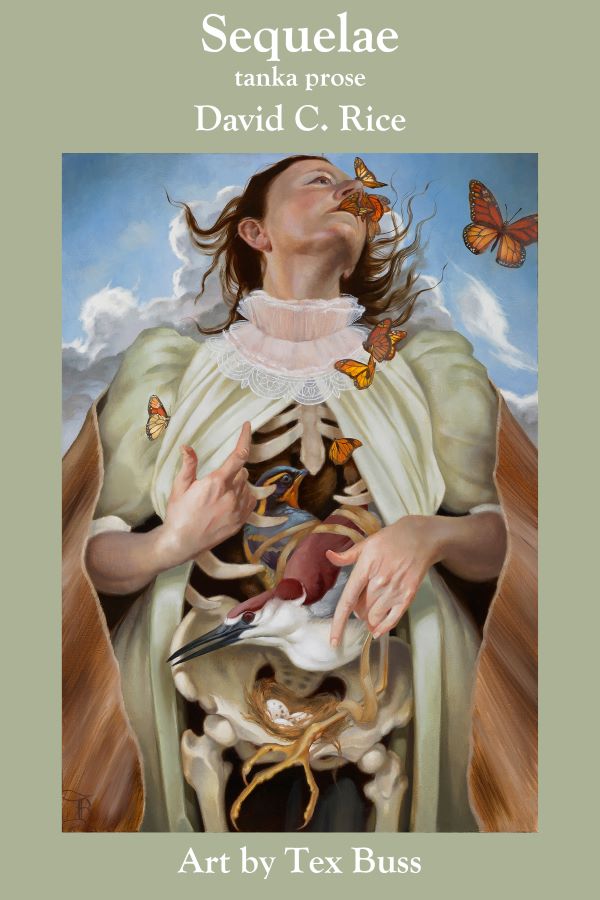Sequela: Nature Poems in Response to Climate Crisis
by David Rice
Art by Tex Buss
Tanka is a lyrical poetic form written in Japan for the past twelve-hundred-plus years and by English-language poets for about a hundred years. It aims to crystallize emotional responses to specific perceptions and often includes a link-and-shift somewhere in its five lines.
dawn
three coyotes watch me
and a thrush sings
could be the last century
— we can’t go back
Adding prose allows the poet to expand the context of the short poem. I have written a tanka prose book, “Sequelae”, that looks at our responses to the climate crisis. Tex Buss’s painting is on the cover, and the book also includes nine of her bird paintings.

Room For Improvement
If we were to change our climate course, who would steer? The wealthiest five-percent, who use thirty-five percent of the carbon, are on cruise control. Those who lack resources are just trying to stay on the road. Can those of us in the middle grab the wheel and turn us off the super-sized highway?
a woodpecker hammers but
that telephone pole
is no longer a tree
how do we drill
beneath our daily routines?
Lost Bird: Reward
Mid-1950s, snow on the ground, and one morning a flock of Evening Grosbeaks in our backyard. The bird book promised warblers in spring. Back then, climate change was for geologists, extinction for dinosaurs.
the global thermometercardinal red
we’re goldfinch
so pleased with our song
we can’t stop
Money, fittest of all survivors, always flies. The oil barons could leave some in the ground, but depending on alpha predators to nurture their prey for the common good is a bad bet. Still, I’ve got to put my chips down . . . on green.
old jigsaw puzzle
a robin hidden
in a leafed-out oak
I must keep looking
for the lost piece
The book also contains four prose birding pieces.
I can close my eyes and see the Short-eared Owl perched on the standing four-foot, broken-off tree trunk in the middle of the meadow as twilight fades to night. Then it’s another year, and I see the full-moon-lit meadow, where magic is afoot and anything is possible.I’ve spent six months here, over a forty-year period, backpack camping at Snag Lake. These trips were Golden Gate Audubon Society birding trips I co-led with Robin Pulich. The tiny lodgepole pines have advanced on the meadow from the forest, and then have died when a heavy snow-melt year submerged the meadow in two feet of water. We’ve seen common birds, rare birds, and once, 300 migrating Rufous Hummingbirds.
Two summers ago, the online map showed that the Dixie fire had burned the entire eastern half of Lassen Volcanic National Park. The park was closed. Last summer, we found small groves that the fire missed and many, many burned trees that were mostly still standing. The birds were there, but in significantly smaller numbers. Next summer, we’ll be back. We’ll look for what has returned and what hasn’t. We’ll keep our eyes open.
David Rice has been a member of GGBA since the late 1970s. He has worked as a psychologist for fifty years, has written tanka for thirty years, co-wrote the Alameda County Breeding Bird Atlas, and has spent many happy days birding up-and-down California.
A GGBA member based in San Francisco, Tex Buss paints birds in watercolors and figurative art in oils, as well as working as a tattoo artist. You can see more of her work on her website, bussfineart.com; on Facebook, Red Kestrel Tattoo; or on Instagram, @authentictattoo.
